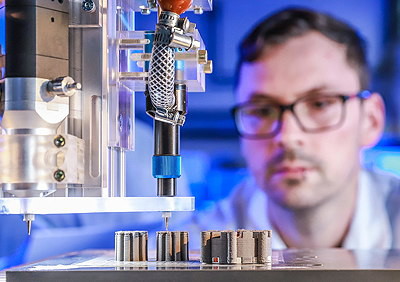‘World’s first’ 3D-printed motor can run at high temperatures
May 11, 2018
German researchers claim to have 3D-printed an entire electric motor for the first time. The researchers, from the Chemnitz University of Technology, demonstrated their machine at last month’s Hannover Fair.

The 3D printing process results in a motor that can operate at much higher temperatures than conventional designs and could thus open up new applications.
Last year, the researchers – Prof Dr Ralf Werner, Johannes Rudolph and Fabian Lorenz – 3D-printed a coil capable of withstanding 300°C. Since then, they have succeeded in printing other key motor components, including copper conductors (which create magnetic fields in combination with iron or iron alloys) and ceramic insulation (which insulates the conductors from each other and from the iron components).
The motor parts are produced by extruding viscous pastes containing particles of materials such as iron, copper or ceramics, and special bonding agents. The pastes are built up layer by layer and then sintered together.
The ceramic insulating pastes, which replace conventional polymer-based insulation materials, can tolerate much higher temperatures. “The maximum permissible winding temperature of 220°C associated with conventional insulation systems can be exceeded by a significant amount,” Werner reports. “The operating temperature of electric machines is therefore limited only by the ferromagnetic properties of the iron components, which can be maintained up to 700°C.”
As well as operating at higher temperatures, the ceramic insulation also conducts heat better, allowing heat losses generated in the conductors to be dissipated quickly. This has helped the researchers to achieve another goal: increasing the output density of electrical machines. Although the 3D-printed copper components are less electrically conductive, in some applications it will be possible to increase efficiency by reducing the winding temperatures significantly.
Rudolph says that the 3D-printed motor is a proof of principle. “It demonstrates the feasibility of our technology,” he declares. He is planning to launch a spin-off company with Lorenz to develop and commercialise the technology.
Source: Drives & Controls